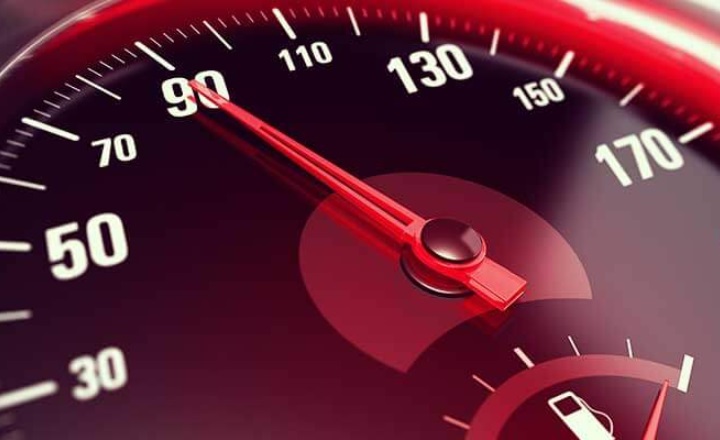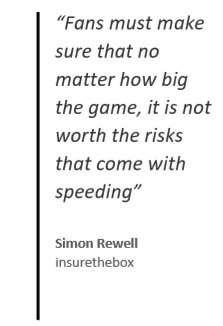
Instances of speeding among young drivers increased by around a fifth in the hour before England’s World Cup matches earlier this summer – and more than 40% before the semi final – new data suggests.
Analysis by insurethebox, providers of black box telematics insurance for young drivers, shows that instances of speeding increased by 43% among the company’s 17-24 year-old drivers, before the semi-final against Croatia.
Speeding also increased before the Sweden quarter-final (23%) and the Columbia round of 16 fixture (14%) – as well as the group stage games against Tunisia (17%), Panama (29%) and Belgium (7%).
Insurethebox says the data ‘suggests that young football fans take their eye off the speedometer and put their foot on the accelerator ahead of a big game’.
With the 2018-19 football season now underway, insurethebox hopes its data can help fans understand that ‘no matter how important the game, they could be scoring an own goal if they don’t keep to the speed limit’.
 Simon Rewell, road safety manager at insurethebox, said: “Fans must make sure that no matter how big the game, it is not worth the risks that come with speeding.
Simon Rewell, road safety manager at insurethebox, said: “Fans must make sure that no matter how big the game, it is not worth the risks that come with speeding.
“Leaving five minutes earlier is a much safer way of getting home for the game – and avoids the risk of a collision that could have lifelong consequences.”
insurethebox says its analysis suggests that the level of speeding during England’s World Cup campaign was largely dictated by the importance of the game.
In the hour before England played Belgium – which was effectively a dead rubber with both teams already qualified for the knockout stage – the incidence of young drivers speeding increased by just 7%.
However, as previously stated, before England’s semi-final against Croatia there was a 43% hike – meaning young drivers spent one in every five miles speeding, compared to the norm of one in every nine miles.
The analysis shows that while young men increased their speed by an average of 38%, speeding among young female drivers increased by 31%.
Commenting on the statistics, Liz Brooker MBE, vice chair of Road Safety GB, said: “Helping young drivers to understand the risks associated with inappropriate speed is vital to help reduce the number of collisions and casualties caused by speeding.
“At Road Safety GB we believe that a combination of communication and intervention can deliver measurable results.
“The 2018 National Road Safety Conference later this year will set out to demonstrate how road safety professionals can combine the four ‘E’s’ – education, enforcement and engineering, underpinned by evidence – to deliver casualty reduction improvements. This analysis by insurethebox will provide useful insight for that debate.”
Through a telematics black box installed in the vehicle, insurethebox uses individual driver data to determine the risk profile of each policyholder and calculate their premiums.
insurethebox shares driving data with customers through a personalised online portal, empowering them to better manage their driving habits in order to reduce their risk profile – and therefore their premiums.
Simon Rewell continued: “Using analysis of more than four billion miles of driving data that insurethebox has collected over the last eight years, we know that young drivers are four times more likely to crash in the first three months of their policy than their final three.
“insurethebox proactively contacts drivers who speed, giving them the information they need to manage their driving behaviour and reduce their risk of an accident.
“Over the last two years, our award-winning speed reduction campaign has used unique insights to enable us to communicate with customers who frequently speed, highlighting the risk of an accident and urging them to slow down and take more care.
“As a result, we have seen speeding instances among the highest risk drivers reduce by about 28%. This has cut the frequency of accidents among young drivers by 9%.”
Yes Hugh. The information held by CRASHMAPS goes back as far as 19 years ago and basic information in terms of numbers of collisions in any one area can be displayed for any number of years. I looked at Calderdale for the last 5 different years and I found that there has been a massive reduction of about 30% in total of collisions more recently but as I have stated they are on main roads and not ones that became subject to the 20 mph scheme.
If details of any one of the collisions is wanted then they can be purchased for £1.00 each but I am sure that this could be open to negotiation.
R.Craven
+3
Just a follow up comment on this: Crashmap appear to have data up to and including 2017. Interestingly, it is now possible, for a fee, to access the individual accident reports including descriptive tests (where available) of what actually happened rather than contacting LAs as previously suggested which would be time consuming. Dates and times of accidents are published, so when the 2018 data is available, it would still be worth a look to see if there is a spike in the period before kick-off times.
Hugh Jones
0
Apart from the speeding data in absolute terms, it would also be interesting to know the increased incidences of hard braking and acceleration for the same periods, which again would reinforce the idea that drivers in a hurry or trying to meet a deadline will exhibit more erratic behaviour than would otherwise be the case.
Hugh Jones
--6
I only suggested it in the interests of accuracy David – I know from comments made on this forum over the years from speeders-in-denial and their sympathisers, how they insist on good, solid, impartial evidence (only in their favour naturally) – so that would be the right way to do it if you could, but having said that, I doubt that LAs would give you the info in the first place and even if they did, you would still have to analyse each collision and decide whether risk-taking and/or carelessness as a result of being in a hurry, was a factor….you’re going to be busy for quite a long time!
If you do get anywhere however, it would be useful at the same time to see if there was a spike in drink-driving collisions around this time, as I know the authorities were concerned about this around the World Cup and relevant campaigns were mentioned in this forum.
ps I would expect the insurance company in question would only have easy access to collision info on some of their own customers, not the whole country’s drivers.
Hugh Jones
--5
Collision data comes mainly from the police and if they don’t let the local council know about a crash (which frequently happens) the council finds out through the issue of Stats 19 data at least 6 months later and that does not include damage only collisions.
We are still waiting for 2017 stats 19 data …..so good luck anyone finding out anything more recent. I’m sure Insurethebox has the collision data on all cars where they have a box fitted.
Pat, Wales
+5
I’d like to think that being a black box that appears to be semi-permanently installed in a vehicle would be able to detect whether or not a semi-serious collision happened.
Anyhow, reading between the lines I have deduced that I won’t be particularly successful in my endeavour as I’m not an “organisation”, but one can only hope the message does miraculously get passed on to someone and as if by magic a press release appears.
And contacting the LA’s highways departments (or their contractors, as the case may be) is a relatively easy, but not necessarily fun task Hugh.
David Weston, Corby
+3
David – you would have to get in touch with all the local authorities’ highways and traffic departments around the UK to get anywhere near an accurate indication of whether there was an increase in road collisions in say, the half-hour before kick-off times – good luck with that.
Hugh Jones
--2
I have contacted insurethebox via its press representative asking the question that I put forward in a previous comment in a somewhat more polite manner.
If I get anything back, I’ll post the response here.
David Weston, Corby
+5
One doesn’t have to be Einstein to reason that drivers in a hurry, whether it’s for kick- off time, job interview, shop closing time, funeral(!) hospital appointments etc., are going to be be more accident-prone due to more risk-taking, speeding and behaviour which would leave no margin for error.
With a national event like a world cup match, the roads would be a lot less populated for the duration and the time leading up to kick-off, which would probably reduce the chances of a collision (note to speeders: this would NOT be a valid defence in Court!)
Hugh Jones
--5
I wonder what percentage increase in accidents occurred during these points in time when these folks were travelling a bit faster on our roads?
I can’t find anything on their press release which denotes any increase in accidents, thus I will be wholly unreasonable and suggest that the increase in accidents due to this is a big fat 0%.
David Weston, Corby
+4